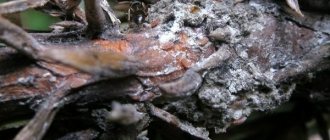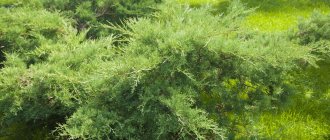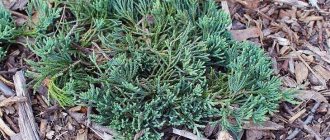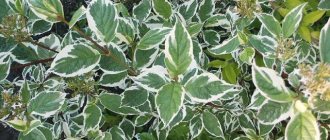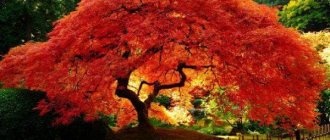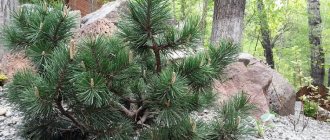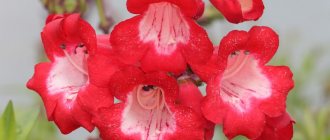Junipers are very popular among amateur gardeners and landscape designers. These evergreen coniferous shrubs do not require much care. They can grow in regions with harsh winters and dry summer months. Dwarf varieties of juniper are ideal for decorating areas of any size. It is only important to take into account the ability of the shoots to grow in width. With their help, you can form a green cover on a rocky area without putting much effort into it. Juniper Expansa Variegata (Juniperus chinensis Expansa Variegata) is an excellent option for decorating a site, regardless of its size and terrain features. This article will discuss how to grow juniper of this variety and how to properly care for it in order to ensure its attractive appearance for many years.
Botanical description
Chinese juniper Stricta Variegata is an evergreen perennial crop of a dwarf form of the Cypress family, which is the result of breeding work by Dutch genetic scientists. The variety of the described perennial was bred in the second half of the twentieth century.
The plant is characterized by small compact size, slow growth rate, at 10 years of age it reaches a height of 2-3 m and up to 1.5 m in diameter.
The shrub has a symmetrical dense crown of a conical shape, represented by a set of straight, thin, fairly rigid shoots growing in a vertical direction relative to the trunk. The needles of the plant are thin, prickly, but at the same time quite soft. In warm periods it has a green-bluish color, and in winter it becomes gray-blue. Feature of the variety
Did you know? In ancient times, dishes were made from juniper wood. In such containers, even in the heat, the milk did not sour and remained sweet and fresh.
The Variegata stricture is the presence of shoots with white and variegated colors, arranged in a chaotic manner, which gives the perennial decorativeness and uniqueness. During the period from August to October, small inedible fruits are formed on the bush - dark blue cones, about 0.8 cm in diameter, on the surface of which a white waxy coating forms. Inside the fruit there are 3 small seeds.
Content:
Chinese juniper (Juniperus chinensis)
As already mentioned, the plant has a wide variety of forms. This is either a tree with a pyramidal crown with an average size of 8-10 m (rarely up to 25 m), or a prostrate tall bush, or a bush pressed to the ground.
The grayish-red bark that encircles the trunks of the coniferous youth peels off in places.
Most leaves-needles are scale-like. The oblong outline of the needles ends with a slightly curved tip, so the coniferous leaves appear blunt-ended at first glance.
In young and strong plants, at the very base on long-standing branches, the leaves are slightly different - needle-shaped. They are interesting because they are collected in bundles of 3 pieces and each such needle is up to 12 mm long. On the inside of the needles there are 2 white stripes with a green median vein.
The color of the foliage is also one of the reasons why this type of juniper is chosen. Among the varieties, you can choose plants of various shades: dark green, bluish-green, yellowish, gray and even variegated whitish.
But the problem is with the cones: in some varieties they are almost spherical, while in others they are elongated. The color of the fruit is the same story - sometimes dark blue, sometimes suddenly black. Their size does not exceed 1 cm.
Characteristic
Juniper from China Strict is valued by gardeners for its ease of cultivation, undemandingness to soil and humidity, and ability to adapt to polluted city air.
The variety has the following characteristics:
| Crown shape | Conical, dense, thick |
| Dimensions | The height of an adult plant rarely exceeds 2-3 m, with a diameter of 1.5 m |
| Rates of growth | Slow, annual growth up to 10–15 cm in height, up to 5 cm in width |
| Root system | Very strong, powerful, branched, can be used to strengthen erosive soils |
| Peculiarities | The plant does not make high demands on the planting site, can grow in soils with low humidity levels, and does not suffer from air pollution |
| Frost resistance | High, which allows you to grow plants almost throughout the entire territory of the Russian Federation |
One of the advantages of the plant is its ability to purify the air and suppress the growth and reproduction of pathogens. This characteristic of culture is often used for therapeutic and preventive purposes. Air enriched with phytoncides secreted by trees has a beneficial effect on the human nervous system, respiratory organs, and promotes rapid recovery of the body after suffering pulmonary ailments.
Important! Juniper needles contain a small percentage of toxic substances, so with prolonged contact with the skin, allergic reactions may occur in some cases.
Reproduction
There are two ways to propagate juniper.
Cuttings
For propagation, cuttings are most often used. The material is harvested at the end of winter. Young shoots covered with bark are separated from the adult plant. The length of the cutting should be approximately 10-25 cm, with at least two internodes, as in the photo.
The cutting is dipped in Kornevin and inserted 2 cm into soil consisting of sand, peat and humus. The seedlings should stand in a bright place under a transparent covering. It should be watered and sprayed. Transplantation into open ground is carried out after a year or two.
By layering
Another method of reproduction is layering. They are easier to obtain from creeping plant varieties.
The side shoots are pressed to the ground with pins. Rooting occurs at the point of contact with the soil. Regular watering is required.
The next year, the young plant is separated and transplanted to the selected area.
Use in landscape design
In the field of landscape design, the described variety of juniper is considered one of the most sought after and popular. It is ideal for creating compositions in Chinese or Japanese style. Due to the fact that the shrub responds well to pruning and shaping, it is often used to form “living” fences, landscaping terraces, balconies and tombstones.
Stricta Variegata looks no less beautiful as part of rockeries, alpine slides, and rocky gardens. It is combined with heather crops and used to decorate garden plots, city alleys and parks. The perennial can often be seen in solitaire plantings or in various group plantings.
Landscape decoration
The design of a garden space using Variegata juniper can be very different. The variety is recommended both for mass plantings and compositions, and for single placement in the garden. If you plant Variegata in a composition with other varieties, it will stand out with its variegation and refresh the appearance of the plantings.
The shrub will look advantageous next to bushes of scarlet and burgundy roses and barberry. If the Cossack Variegata is planted under a tall coniferous tree, then such a picture will make even a compact garden plot more atmospheric and cozy.
Experts who have been studying landscape design for a long time recommend using Variegata in places where you need to play up the slope of the earth, sharp corners or tiered compositions. Emerald needles with sun spots will perfectly hide all the imperfections of the territory, presenting it in a favorable light.
Gardeners who planted Variegata juniper in their dacha do not regret this choice. According to reviews from summer residents, the plant, although slowly, is growing steadily. Care is simple and consists of several feedings, 3-4 waterings per season and other simple manipulations. However, it should be remembered that the plant is poisonous. It is better not to purchase it for a garden where children often visit.
0 0 votes
Article rating
How to plant juniper
As already noted, juniper is not too demanding on the location, soil composition and climatic conditions of the region. However, in order to grow a decorative, aesthetically attractive shrub, it is recommended to follow some basic rules when planting it.
Find out more about when is the best time to replant juniper to a new location.
Preparing the site
Stricta prefers to grow in well-lit sunny places or in slight partial shade. It should be noted that the needles of a young plant are quite sensitive to direct rays of the sun, so the seedlings need to be shaded. Optimal for the plant is light, nutritious, air- and moisture-permeable soil with a neutral or weak acidity level.
However, the crop can normally tolerate dry, calcareous and sandy soil. It is important to ensure that the area is protected from drafts and cold winds, which negatively affect the condition of the bush and can provoke the development of fungal diseases.
Recommendations for choosing seedlings
Experts recommend purchasing seedlings in special nurseries or specialized markets.
When choosing planting material, you need to pay attention to the following aspects:
- preference should be given to plants with a closed root system or seedlings in containers;
- the material must have young shoots;
- juniper branches should be elastic, fresh, without signs of dryness and brittleness;
- The crown of the bush should be a rich, bright color, without dry areas, signs of diseases or parasites.
When planted, a seedling that is placed in a container takes root much better, takes root and adapts to a new place much faster.
Landing rules
Planting is allowed in the spring - in April, when the likelihood of the return of night frosts disappears, or in the fall - in October, a few weeks before the expected cold weather.
Important! Bare-rooted seedlings should be planted immediately after purchase.
The planting technology is simple and is based on the following steps:
- Dig a hole the size of which is 2-3 times the size of the root system.
- Line the bottom of the pit with a 20-centimeter layer of drainage made of expanded clay or pebbles.
- Mix part of the withdrawn soil in equal proportions with peat and add to the mixture a complex mineral preparation intended for coniferous species.
- Place a layer of fertile soil on top of the drainage layer.
- Place the seedling in the hole and cover it with soil so that the neck of the root remains on the surface.
- Lightly compact the soil with your hands and water the seedling generously with settled, non-cold water.
- Cover the trunk circle with a layer of bark or wood chips mulch.
If the plant is located in a sunny place, it is recommended to protect it from sunlight in the first weeks. When planting several specimens, an interval of 0.5 to 2 m should be maintained between them, depending on the size of the seedlings.
Variety Variegata
Juniper Green Carpet: description and characteristics of the variety
Juniper Variegata belongs to the Cossack species. Cossack heather as a type of flora can be seen in forests and mountains in all parts of the largest continent of Eurasia. This plant became the progenitor of new varieties that fit perfectly into the atmosphere of a well-kept garden. Breeders work with a huge number of different groups of juniper. Among them was the Cossack juniper Variegata.
Note! This variety was known in ancient times. If you study Latin, Variegata means motley in a dead language. In the new millennium, improved culture is rapidly gaining popularity.
Juniper Cossack Variegata the description begins with the information that it is a beautiful horizontal dwarf. One of the best representatives of the species. Its shape is fire-shaped. The plant is quite dense and compact, especially if grown in the sun.
Like other Cossack junipers, Variegata has extremely slow growth. In 1 month, the plant can grow only 0.5 mm of tissue. The height of a young plant, which is 3 years old, is only 20-26 cm. At this age, the crop acquires a crown, the diameter of which is 15-22 cm. Over several decades, Variegata takes on the appearance of a meter-high shrub with a lush crown covered with delicate scales. The tops of the shoots bend and reach towards the sky. The fruit cones are small. Their color is brown. They are practically invisible through the thickets of the crown.
A special feature of the Cossack variety Variegata is the unusual color of its needles. It is emerald with sunny splashes. The spots are cream-colored with a yellow tint. The crown has a bright, thick aroma. It becomes more resinous and richer if you don’t just approach the bush, but crush a couple of branches in your hands. The smell is due to the presence of essential oil. Owners of a decorative species should be careful - the oil contains a small amount of a toxic substance.
Juniper Variegata
Cossack Variegata is a bit like the Chinese juniper Expansa Variegata. They are both low growing and both have light highlights on their branches. However, the Expansa Variegata juniper is distinguished by its thorny needles, and it is not recommended to plant it in the northern regions, in central Russia and the Urals due to its low frost resistance.
Diseases and pests
Most often, Chinese juniper is affected by fungal diseases, which may be caused by unfavorable climate conditions or poor care. A perennial can become a “victim” of more than 40 species of fungi that infect the roots of the plant, which subsequently affects the shoots and needles.
Did you know? It is surprising that natural juniper thickets are localized near coal seams. This property is used by geologists to search for coal deposits. This is how the coal basin was discovered in the Moscow region.
Common signs of fungal infection are:
- yellowing and further falling of needles;
- yellowing and drying of shoots;
- the appearance on the needles and shoots of spots of various colors: brown, dark, yellow.
The most common diseases of juniper are fusarium, brown schutte, and rust. If a perennial becomes infected, all diseased parts should be carefully trimmed and destroyed. Trees must be sprayed with fungicidal preparations, for example, “Fundazol”.
Of the pests that cause the greatest harm to the crop: sawfly, needle mite, aphid . Pests feed on the sap of the plant, which is why it gradually fades, the shoots and needles dry out. An effective method of controlling parasites is to spray the bushes with broad-spectrum insecticides, for example, “Aktara” or “Aktellik”.
Preventive treatment of trees with insecticides and fungicides allows you to avoid the development of fungal diseases and the appearance of insect pests.
Care
Juniper Skyrocket rocky: description and characteristics
The plant will not require a lot of time from the owner of the site. Caring for the crop is not labor-intensive. Among the main events:
- Watering;
- Weeding;
- Mulching;
- Feeding;
- Trimming;
- Pest and disease control.
Watering, weeding and mulching
Cossack juniper Variegata calmly tolerates drought, but to accelerate growth it is watered once every 30 days. It is allowed to irrigate the bush every week with a spray bottle with clean warm water. But it is recommended to do this after sunset. After watering, the ground under the bush is weeded and mulched with dry leaves, peat, and sawdust.
Watering juniper
Top dressing
One or two fertilizing per year is enough for the culture. The procedures are performed at the very beginning and at the end of spring. Nitroammophoska is planted under the bush. Another good universal fertilizer is Kemira.
Trimming
The variety tolerates pruning well. But here it is important for the gardener not to overdo it. The first 3 years after planting, the juniper is only slightly trimmed. Only old and dried branches are removed. After 3 years spent on the site, the plant is allowed to take the shape that the landscape designer intended.
Fighting diseases and insects
The disease to which the variety is susceptible is brown snow mold (Schütte brown). Fallen needles are burned, damaged shoots are cut off. The plant is sprayed with Bordeaux mixture.
The plant can become infected with rust, which comes from rowan or pear. As a preventive measure, Cossack juniper Variegata is planted away from these trees. If rust is already noticeable, then all damaged shoots are removed from the bush. Afterwards it is treated with Topaz. This product is used twice per season.
Rust on juniper
Insects do not like the smell of juniper, so they rarely attack the elegant shrub. However, it happens. The most courageous pest that is not afraid to attack a representative of the Cypress family is the spider mite. Acaricides are used to combat it:
- Anti-mite;
- Neoron;
- Apollo;
- Fitoverm;
- Omite etc.
Another pest that spoils juniper is ants. These insects carry other parasites, such as aphids and scale insects. As soon as the gardener saw ants crawling around the crop, he immediately sprayed the bush with Thunder, Ant, Fufanon.
Additional Information. The planting should be protected from pets. Waste from cats and dogs destroys the plant.
Landing rules
Chinese Strict juniper seedlings must be purchased only from specialized nurseries or from breeders. Only in this case can you be sure of the proper quality of planting material. Seedlings are sold in pots and should not show signs of mold or other diseases.
For the seedling, choose an open sunny area, but protected from strong winds. Locations with low groundwater levels are preferred. The distance to other perennial plants and buildings should not be less than 200-250 cm.
The soil for the plant is light and moisture-permeable. Juniper grows well on sandy and calcareous substrates. It should not be planted on heavy loams and clean peat bogs. The optimal combination of soil components for a plant:
- turf or garden soil 1 part;
- coarse river sand 1 part;
- high non-acidic peat 2 parts.
Before planting the seedling, mineral fertilizers for coniferous plants are applied to the holes, according to the instructions.
Important! Do not add fresh manure or partially decomposed compost!
Decorative conifers are planted in April - May, but with proper care, plants can be planted until the beginning of September. When planting conifers in summer, it is necessary to shade the crown from the scorching sun with lutrasil and spray the needles daily with warm water.
- The diameter of the planting hole should be 2 times the diameter of the root system of the seedling. About 15 cm of pebbles or crushed stone are poured into the bottom of the hole as a drainage layer. Juniper is sensitive to stagnation of water in the root zone.
- The hole is partially filled with prepared soil. The seedling is placed in the center of the hole and the roots are carefully straightened. The hole is filled with earth, tightly engrafting it to the roots of the plant.
- The root collar of the bush should protrude 5-6 cm above the soil surface.
- Planted junipers are watered abundantly and mulched with tree bark and peat.
The distance between plants is from 100 to 250 cm. Meter gaps between trees are left when juniper is grown as a hedge.
